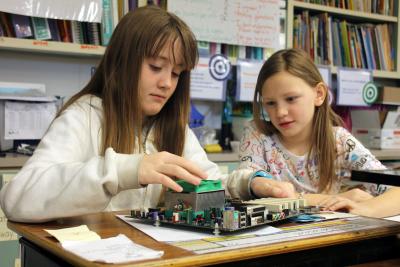In November 2010, voters approved a mill levy and bond issue. Bond funds are one-time dollars that allow the district to maintain excellent facilities critical to providing a positive learning environment. t
Learn more about the bond-funded construction projects, new technology initiatives, and special projects teachers created using grants funded by the 2010 mill levy override below.
2010 Bond building und
The bond provided $120 million for improving, equipping, and furnishing district buildings and other properties. Over its eight-year time frame, the bond provided funding for infrastructure repair projects, which extends the life of facilities and provide an optimal level of efficiency and effectiveness for students and staff. To date, more than 450 projects, totaling approximately $81 million, have been completed.
This work included improvements related to:
- New technology in schools to provide learning opportunities for students
- Improved safety and security in district schools and facilities
- Maintaining, upgrading and improving schools and facilities, including ADA compliance, roofs, electrical systems, plumbing, fire protection, heating and ventilation systems, kitchens, flooring, lighting and school grounds
Projects lists:
2017 Bond construction video update
2010 Mill Levy use plan
The Mill Levy provided $16 million annually for specific educational purposes in schools and the district. The impact to taxpayers was phased in from 2011-2013.
Schools received 2010 mill levy funds each year to support student instruction and academic excellence. Resources provided teachers with professional development and collaborative time for curriculum development work. Mill levy money improved technology resources for students and staff at all schools. Teaching and other instructional positions (previously lost to budget cuts) were also restored by mill dollars to increase learning opportunities for students.
2010 Mill Levy money supported:
Academic Excellence
- School Allocations - $6.1 million allocated annually to schools to restore teaching positions (previously lost to budget cuts) or add staffing, and provide resources to support academic achievement. School plans may include components for physical education, wellness and support for whole child instruction, including specials such as music, art and gifted and talented education. Charter school allocations included $785,000 distributed to Liberty Common School and Ridgeview Classical School based on proportionate shares determined by the 2010 student count.To see a school accountability plan, email info@psdschools.org.
- School Innovation Grants - $300,000 dedicated annually for schools to apply for grants. Schools can request up to $25,000 per application to support innovative programs that address at least one of the following: third-grade reading proficiency, annual academic growth, successful transitions and post-secondary readiness. The School Innovation Review Committee evaluated all applications. To see a school innovation grant, email info@psdschools.org.
- Colorado Standards Implementation - $1 million in funding to give teachers time and collaborative opportunities to implement new Colorado content standards ($500,000) and develop common assessments to measure student progress, as well as ensure alignment of standards and 21st century skills integration ($500,000)
- Mentoring Program - $300,000 is dedicated to support and help new teachers during their first two years to help them be successful.
- Early Childhood Education and Kindergarten Programs - $200,000 each year to Early Childhood Education programs and kindergarten tuition scholarships
Technology Refresh and Support
- Educational Technology for Students - $6 million allocated annually to improve educational technology for students in all schools. Mill funds allow classrooms to have updated computers and other technology resources, giving students 21st century learning environments. Thousands of computers have been refreshed for students and staff; SmartBoards have been installed in many classrooms; and at the high school level, all students are given a device. Teachers receive professional development annually on technology applications and teaching tools, as well as on enhancing student learning by using SmartBoards, Netbooks and laptops in lessons.
- District Technology Infrastructure - $1 million allocated annually toward improving the district technology infrastructure. Mill money supports the network and software, providing connectivity efficiency for the Internet and other applications, including the PSD website and Student Information System.
Workforce Development and College Readiness
- Concurrent Enrollment program - $200,000 for concurrent enrollment opportunities for students to take college classes. (Colorado statute requires districts to pay tuition for credit at a community college for concurrent enrollment classes students complete as part of their four-year high school plan or ICAP).
- School Innovation Grants - $300,000 dedicated annually for schools to apply for innovation grants. Schools can request up to $25,000 per application to support programs that address: third-grade reading proficiency, annual academic growth, successful transitions and/or post-secondary readiness.


